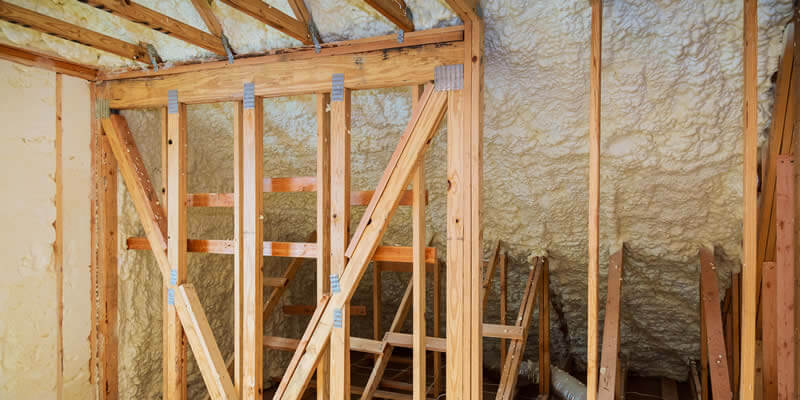Cost Range for Spray Foam Insulation
The cost range to have spray in foam insulation installed at your home is between $1.65 – $4.75 per square foot when hiring a local company to do the job. A board foot is one square foot of space, with 1″ thickness of insulation applied to it.
Average Cost
Overview of Spray Foam Insulation
Spray-on open cell or closed cell spray foam insulation can be for a whole-house insulation or used in specific locations where an airtight, air barrier seal with a good R-value is required. When used throughout the building envelope of a structure, the cost is significantly higher than fiberglass or blown cellulose, but that extra expense is paid back in 3-7 years in most climates through superior energy savings from your utilities and home HVAC systems. Because spray foam insulation also acts as a moisture barrier, it is frequently used in crawl spaces, exterior walls and attics. Common spot applications include sealing air gaps around outlets, light fixtures, window and door frames, foundation sill plates, vents and other openings in the structure’s exterior as part of regular home maintenance.
This Costimate explains how you can figure open cell spray foam insulation costs, broken down into material and labor costs. Your research here will allow you to accurately estimate your costs before talking to a pro for spray foam insulation. In many homes and other structures, both spray foam insulation and blown-in insulation are used to insulate the same space for the greatest r-value and energy savings. At the end of the page, compare costs shared by other leading cost comparison websites.
Spray Foam Insulation Cost Factors
The cost factors below are focused on large applications of spray foam to a new home or adding new insulation to an existing home.
- Who does the Work – DIY foam insulation kits are available online and at home improvement stores. Most are sold in 600 or 1,200 board feet capacity. A board foot is one square foot, one inch thick insulation application.
- Size of the Job – When large areas like an entire home are insulated, the cost per square foot is lower than when just an attic or crawlspace is insulated. This is because travel and setup costs are distributed over the larger square footage.
- Open-cell or Closed-cell Foam – Open-cell spray insulation costs less and has an R-value of about 3.5 per inch; The insulation value of costlier closed-cell foam insulation is R6.0 to R7.0 per inch of thickness. Both seal air leaks, so if that is the material’s primary purpose in your application, then open-cell material is a good choice. Only closed-cell foam is a moisture barrier and it is a better choice in crawlspaces. Choosing the right types of spray foam will b something a professional discusses with you, when comparing to traditional insulation.
- Layer Thickness –The US Department of Energy’s Energy Star program recommends R30 to R60 for attics and R13 to R30 for walls depending on your region of the country. This makes spray foam insulation an expensive option as the only form of insulation. In many applications, an inch or two of spray foam insulation is used to create a moisture barrier or seal air leaks before fiberglass insulation or blown cellulose insulation is installed to achieve the required insulation value (R-value).
- New, Remodeling or Existing Construction – Homes and commercial buildings are much easier to insulate during construction and when being “gutted” than once completed, so the cost is lower.
- Ease of Access – In existing construction, the more difficult it is to access the space where spray foam insulation will be applied, as in a crawlspace for example, the higher the cost.
- Prep work – Spray foam insulation must be applied to surfaces that are free of dirt, dust, oil and other debris. How much cleanup must be done prior to spraying will affect cost. Installing baffles, blocks and covers in attics to protect soffit vents, ridge vents and recessed lights produces a slight rise in cost.
Note: For spot applications or small projects, most homeowners get cans of spray foam and apply it where needed. You might also hire a handyman for $35-$55 per hour plus materials at $13-$16 per 30 ounce can of spray foam.
Foam Insulation and Installation Supplies Cost
Here’s an itemized list of the insulation, additional materials and tools needed for the job, so you can compare total costs of installing the insulation yourself or hiring an installer. Spray foam insulation estimates from contractors near you won’t be this detailed. To learn about the DIY aspect, how much you need to order etc, Sprayfoamkit.com offers a great tool to calculate costs.
- $1.25-$1.85 per board foot of coverage | DIY spray foam insulation kits for 600 to 1,200 board feet of coverage that include insulation, sprayer, hose, tips and other required accessories (but no safety items).
- $22-$40 each | Respirator for healthy breathing during installation
- $4-$8 per box of 50 | Vinyl or nitrite gloves
- $4-$8 per pair | Vented, low-impact goggles
- $30-$40 per kit | Some DIY spray foam insulation kit sellers offer a Personal Safety Kit with respirator, gloves, goggles and a suit made of Tyvek or similar material
- $11-$20 each | 4’x8’ rigid foam insulation, cut into baffles to position between rafters to prevent spray foam insulation from blocking airflow through soffit vents. One board is sufficient for an attic up to about 1,500 square feet.
- $10-$18 each | Drywall saw for cutting rigid foam
- $6-$15 each | 20’ Tape measure for determining how many square feet you plan to cover
For comparison value, spray foam insulation when supplied by the installer costs around $0.75 – $1.25 per board foot, installed.
Remember: One board foot is a square foot covered to a depth of one inch, about R3.5 for open-cell insulation and about R6.5 for closed-cell insulation. Multiply the board foot cost by the number of inches you plan to install to get the intended R-value.
Permits, Inspection, Related Costs and Installation Time
Permits and Inspection Cost
- $0 | A separate permit is not required in most communities to install spray foam insulation.
Related Costs and Installation Time
From the prices above, you see that the cost of the material is less when installed by a professional. This is because they buy it in such large volume that they get a discount. The total job will cost more when professionally installed vs. DIY installation. It’s clear, then, that your decision comes down to whether paying the extra cost is worth saving yourself the time and hassle and being assured of professional results.
- $0.30-$1.15 per board foot | Professional installation cost. The cost varies based on who does the work. The cheapest estimates are given by unlicensed handyman services, and the highest rates are charged by licensed, insured insulation contractors. In between are licensed handyman services. Just be sure the person you hire has experience in preparing the surfaces and applying the material.
Caution: It is essential when spraying insulation over a ceiling (rather than to the underside of the roof deck) that attic vents remain open. If they are covered, moisture and heat will build up in the attic and cause mold, rot and roof damage.
Spray Foam Insulation, Installation Time Schedule
Small jobs such as a small attic or crawlspace take up to one day. The timeframe for larger jobs looks like this for a two-person crew:
- 1 Day: Cleaning, surface prep, taping off areas to avoid overspray
- 1 Day: Attics and full basements up to about 1,500 square feet or crawlspaces up to about 2,000 square feet
- 2 Days: Large attics and full basements
- 3-4 Days: Entire homes including wall, ceiling and basement insulation
Related Projects
Having a properly insulated home is important to not only save energy, but also keep your home warm or cool during the various seasons when cooling and heat is needed. Explore these other related projects at Costimates.
Are You a Pro Spray Foam Insulation Installer?
If so, head over to our Costimates Pro’s page, and help us make this page better and more accurate for both our visitors and your future customers.
DIY or Hire a Pro?
For spot applications, applying spray foam is easily a do-it-yourself job for the handy homeowner. If you plan to update your homes existing insulation with a broad application of spray foam to attics, basement, crawl space or some other larger area, this is definitely best left to the pros. They have the tools, knowledge, experience and safety equipment to do the job quickly and right.
- Great DIY project for spot sealing gaps around windows, doors, etc.
- You’ll need to get dirty on existing home applications, as well as spending more money to complete the project.
- Safety is a key item around these spray foam products.


 Steve Hansen, that's me, the Senior Editor of Costimates. (
Steve Hansen, that's me, the Senior Editor of Costimates. (